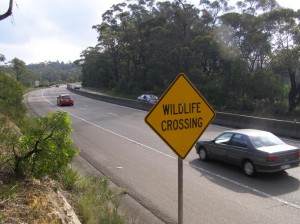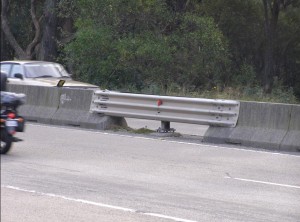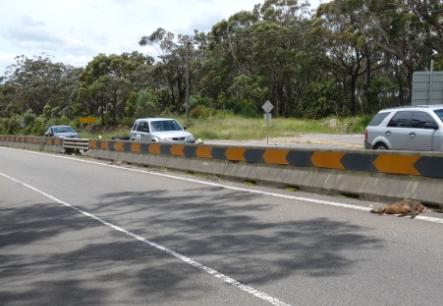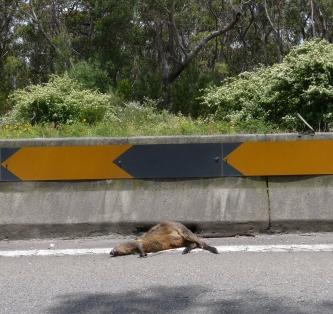Wildlife Crossing in the Blue Mountains
Monday, March 29th, 2010by Editor 20100329.
The Editor had been intending to take the following two photographs for some years.
Perhaps self-evident, but the first shows a ‘wildlife crossing’ sign by the NSW Roads and Traffic Authority (RTA) at the side of a widened busy four lane section of the Great Western Highway on the Boddington Hill climb at Wentworth Falls, Blue Mountains, in Australia.
The second photo shows a two metre provision for wildlife to cross under the barrier in the middle of a one kilometre long continuous concrete median barrier. This section being on a 80kph downhill bend and typically ignored.
Presumably, the only wildlife crossing would be guaranteed to become ‘road kill’. This wildlife crossing is greenwash tokenism at its disingenuous best.
This section of the Great Westren Highway traverses a ridgeline through a narrow land zone excluded from listing in the Greater Blue Mountans World Heritage Area, atthis location just 500 metres away. Another reason why the Blue Mountains while conveying a first impression of wild and protected, is almost devoid of the ground dwelling mammals that were once prolific.
Throughout the Blue Mountains, no wildlife corridor provision exists. Indeed, local residents have their own disputes with this arrogant state government department to achieve local pedestrian and vehicular crossings of the expressway development, let alone wildlife. What wildlife?

 Actual wildlife crossing provided by the RTA
Photo by Editor, 20100327
Actual wildlife crossing provided by the RTA
Photo by Editor, 20100327
Scientifically Recorded species of the Upper Blue Mountains:
Short-Beaked Echidna ( Tachyglossus aculeatus )
Tiger Quoll (Dasyrus maculatus)
Brown Antechinus ( Antechinus stuartii )
Dusky Antechinus ( Antechinus swainsonii )
Common Ringtail Possum ( Pseudocheinus peregrinus )
Common Brushtail Possum ( Trichosurus vulpecula )
Swamp Wallaby ( Wallabia bicolour )
Grey Headed Flying Fox ( Pteropus poliocephalus )
Bush Rat ( Rattus Fuscipes)
Swamp Rat (Rattus lutreolus)
Garden Skink (Lampropholis guichenoti)
Blue Mountains Water Skink (Eulamprus leuraensis)
Eastern Water Skink (Eulamprus quoyii)
Blotched Blue Tongue (Tiliqua nigrolutea)
Pink –Tongued Lizard ( Hemisphaeriodon gerardii)
Weasel Skink ( Saproscencus musteline)
Copperhead ( Austrelaps superbus )
Eastern Brown Snake ( Pseudonaja textiles )
Red – Bellied Black Snake ( Pseudechis porphyriacus)
Common Eastern Froglet ( Crinia signifera )
Striped Marsh Frog ( Lymnodynastes peronii )
[Source: Extract from FAUNA OF THE GULLY, Upper Kedumba River Catchment, Les Peto 2007].Sightings of these species are so rare these days as to almost, sadly, presume that many have been forced into local extinction by colonist Australians and their descendants and subsequent immigrants.
On 20th December 2010, a local reader sent in the following photographs of the same ‘wildlife crossing’ site where a wallaby had been killed. Many motorists use the derogatory term ‘roadkill’, but this reader certainly conveyed a higher respect for our wildlife. The reader contributed the following personal account with the photos:
.
“It shows a swamp wallaby roadkill less than ten metres from the so-called ‘wildlife crossing‘. The carcass has been there for a few days – as a mountains resident you have probably already seen it for yourself.I too have been wanting to take a photo of the site for the last few years and was prompted to do so after the events of yesterday. I was heading down the highway on my way to work in the morning when I spotted the wallaby on the road. This was the first time in the four years I’ve been living in the mountains that I have seen any significant roadkill at the site, and I felt sickened as I have always considered the wildlife crossing an absolute joke, but now it’s become deadly serious. Further, only two minutes after I saw the wallaby, I came across an injured sulfur-crested cockatoo in the middle of the highway at Bullaburra. After wrapping it up in a jumper, I got my partner to come down from our home in Wentworth Falls to retrieve it, and it subsequently died just before reaching the local WIRES volunteer’s home. Yesterday’s events have inspired me to address the issue of the complete lack of any facilitation of wildlife movement across the highway – a huge barrier separating the northern and southern sections of the mountains. This has led me to your website – and it is heartening to know that there are plenty of others out there who are also disturbed by the status quo. “
.
© The Habitat Advocate Public Domain









